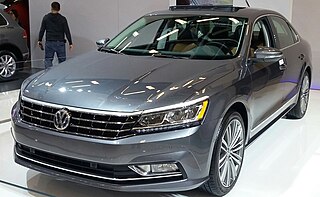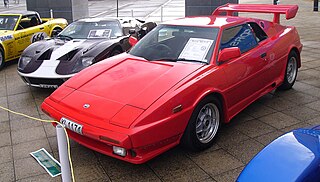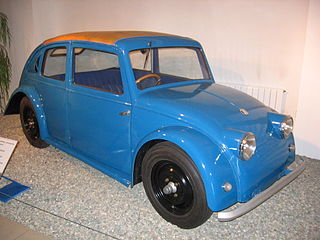
The Porsche 914 or VW-Porsche 914 is a mid-engined sports car designed, manufactured and marketed collaboratively by Volkswagen and Porsche from 1969 to 1976. It was available as a targa-topped two-seat roadster powered by either a flat-4 or flat-6 engine.

The Volkswagen Beetle—officially the Volkswagen Type 1, informally in German the Käfer, in parts of the English-speaking world the Bug, and known by many other nicknames in other languages—is a two-door, rear-engine economy car, intended for four occupants, that was manufactured and marketed by German automaker Volkswagen (VW) from 1938 until 2003.

The Volkswagen Scirocco is a three-door, four passenger (2+2), front-engine, front wheel drive sport hatchback manufactured and marketed by Volkswagen in two generations from 1974 to 1992 and a third generation from 2008 until 2017. Production ended without a successor.

The Volkswagen PhaetonFAY-tən is a Full-size luxury sedan/saloon manufactured by the German automobile manufacturer Volkswagen, described by Volkswagen as their "premium class" vehicle. Introduced at the 2002 Geneva Motor Show, the Phaeton was marketed worldwide. Sales in North America ended in 2006 and global sales ended in 2016.

A W12 engine is a twelve cylinder piston internal combustion engine in a W configuration. W12 engines have been manufactured in two distinct configurations. The original W12 configuration used three banks of four cylinders coupled to a common crankshaft, with 60° angles between the banks. These were used in several aircraft engine designs from the 1920s, notably the Napier Lion and various French engines. The more recent configuration, used in the Volkswagen Group W12, uses four rows of three cylinders merged into two 'cylinder banks', coupled to a common crankshaft.

The Volkswagen Type 3 is a compact car that was manufactured and marketed by Volkswagen from 1961 to 1973. Introduced at the 1961 Frankfurt Motor Show, Internationale Automobil-Ausstellung (IAA), the Type 3 was marketed as the Volkswagen 1500 and later as the Volkswagen 1600, in three body styles: two-door Notchback, Fastback and Squareback, the latter marketed as the 'Variant' in most markets, and 'Squareback' in the United States.

In automotive design, an RR, or Rear-engine, Rear-wheel-drive layout places both the engine and drive wheels at the rear of the vehicle. In contrast to the RMR layout, the center of mass of the engine is between the rear axle and the rear bumper. Although very common in transit buses and coaches due to the elimination of the drive shaft with low-floor bus, this layout has become increasingly rare in passenger cars.

The Stout Scarab is a 1930–1940s American minivan. It was designed by William Bushnell Stout and manufactured by Stout Engineering Laboratories and later by Stout Motor Car Company of Detroit, Michigan.

The FSO Polonez was a Polish motor vehicle that was produced from 1978 to 2002. The car's name comes from the Polish dance, polonaise.

The Volkswagen Country Buggy is a small utility vehicle designed and built by Volkswagen in Australia and the Philippines. It used parts from the existing Type 1 and Type 2. Production ran from 1967 to 1968. A derivative of the Country Buggy called the Sakbayan was built in the Philippines for several years until 1980.

The Czechoslovakian Tatra 77 (T77) is the first serial-produced, truly aerodynamically-designed automobile. It was developed by Hans Ledwinka and Paul Jaray, the Zeppelin aerodynamic engineer. Launched in 1934, the Tatra 77 is a coach-built automobile, constructed on a platform chassis with a pressed box-section steel backbone rather than Tatra's trademark tubular chassis, and is powered by a 60 horsepower (45 kW) rear-mounted 2.97-litre air-cooled V8 engine, in later series increased to a 75 horsepower (56 kW) 3.4-litre engine. It possessed advanced engineering features, such as overhead valves, hemispherical combustion chambers, a dry sump, fully independent suspension, rear swing axles and extensive use of lightweight magnesium alloy for the engine, transmission, suspension and body. The average drag coefficient of a 1:5 model of Tatra 77 was recorded as 0.2455. The later model T77a has a top speed of over 150 km/h (93 mph) due to its advanced aerodynamic design which delivers an exceptionally low drag coefficient of 0.212, although some sources claim that this is the coefficient of a 1:5 scale model, not of the car itself.

The Volkswagen Golf Mk5 is a compact car, the fifth generation of the Volkswagen Golf and the successor to the Volkswagen Golf Mk4. Built on the Volkswagen Group A5 (PQ35) platform, it was unveiled at the Frankfurt Motor Show in October 2003 and went on sale in Europe one month later. A compact MPV version of the car was produced as the Golf Plus.

The Volkswagen Golf Mk1 is the first generation of a small family car manufactured and marketed by Volkswagen. It was noteworthy for signalling Volkswagen's shift of its major car lines from rear-wheel drive and rear-mounted air-cooled engines to front-wheel drive with front-mounted, water-cooled engines that were often transversely-mounted.
The SA was Toyota's first new passenger car design after World War II. It was the first in a family of vehicles before the introduction of the Crown. A series of light trucks also shared the chassis and major components of these passenger cars.

The Volkswagen Passat is a mid-sized sedan that debuted in January 2011 at the Detroit Auto Show, is manufactured at the Volkswagen Chattanooga Assembly Plant, replaces the Passat B6 in the North American market, and is marketed also in South Korea.

The Volkswagen Golf Mk6 is a compact car, the sixth generation of the Volkswagen Golf and the successor to the Volkswagen Golf Mk5. It was unveiled at the Paris Auto Show in October 2008. Volkswagen released pictures and information on August 6, 2008, prior to the official unveiling. The vehicle was released to the European market in the winter of 2008. Major investments have been made in production efficiency, with a claimed productivity improvement at launch of nearly 20% in comparison with the previous model, and further gains planned for the next twelve months.

A rear-engine, front-wheel-drive layout is one in which the engine is between or behind the rear wheels, and drives the front wheels via a driveshaft, the complete reverse of a conventional front-engine, rear-wheel-drive vehicle layout.

The Volkswagen Polo Mk5 is the fifth generation of the Volkswagen Polo supermini-class car, launched by Volkswagen in March 2009.

Heron Cars were racing cars, sports and kit cars built in New Zealand between 1962 and 1999 by Ross Baker. They also included a one-off electric car.



















